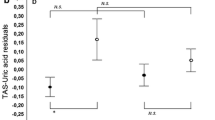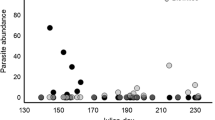Abstract
Parasites are undoubtedly a biotic factor that produces stress. Heat shock proteins (HSPs) are important molecules buffering cellular damage under adverse conditions. During the breeding season, blue tit Cyanistes caeruleus (L.) adults are affected by blood parasites, nest-dwelling parasites and biting flies, potentially affecting their HSP-mediated responses. Here, we treated females with primaquine to reduce blood parasites and fumigated nests with permethrin to reduce nest-dwelling parasites to test whether these treatments affect HSP60 level during the breeding season. Medicated females, but not controls, had a significant reduction of the intensity of infection by Haemoproteus spp. blood parasites. However, final intensity of infection did not differ significantly between groups, and we did not find an effect of medication on change in HSP60 level. Fumigation reduced the abundance of nest-dwelling parasites (mites, fleas and blowfly larvae) and engorged biting midges in nests. Females breeding in non-fumigated nests increased HSP60 levels during the season more than those breeding in fumigated nests. Furthermore, the change in HSP60 level was positively correlated with the abundance of biting midges. These results show how infections by nest ectoparasites during the breeding period can increase the level of HSPs and suggest that biting midges impose physiological costs on breeding female blue tits. Although plausible, the alternative that biting midges prefer to feed on more stressed birds is poorly supported by previous studies.




Similar content being viewed by others
References
Anand S, Pal JK (2002) The haem-regulated eukaryotic initiation factor 2 alpha kinase: a molecular indicator of lead-toxicity anaemia in rabbits. Biotechnol Appl Biochem 36:57–62
Arriero E (2009) Rearing environment effects on immune defence in blue tit Cyanistes caeruleus nestlings. Oecologia 159:697–704
Arriero E, Moreno J, Merino S, Martínez J (2008) Habitat effects on physiological stress response in nestling blue tits are mediated through parasitism. Physiol Biochem Zool 81:195–203
Atkinson CT, van Riper IIIC (1991) Pathogenicity and epizootiology of avian haematozoa: Plasmodium, Leucocytozoan, and Haemoproteus. In: Loye JE, Zuk M (eds) Bird–parasite interactions: ecology, evolution and behaviour. Oxford Univ Press, Oxford, pp 19–48
Bouslama Z, Lambrechts MM, Ziane N, Djenidi R, Chabi Y (2002) The effect of nest ectoparasites on parental provisioning in a north-African population of the blue tit Parus caeruleus. Ibis 144:E73–E78
Buchanan KL (2000) Stress and the evolution of condition-dependent signals. Trends Ecol Evol 15:156–160
Burkett-Cadena ND, Ligon RA, Liu M, Hassan HK, Hill GE, Eubanks MD, Unnasch TR (2010) Vector–host interactions in avian nests: do mosquitoes prefer nestlings over adults? Am J Trop Med Hyg 83:395–399
Christe P, Richner H, Oppliger A (1996) Begging, food provisioning, and nestling competition in great tit broods infested with ectoparasites. Behav Ecol 7:127–131
Darbro JM, Dhondt AA, Vermeylen FM, Harrington LC (2007) Mycoplasma gallisepticum infection in house finches (Carpodacus mexicanus) affects mosquito blood feeding patterns. Am J Trop Med Hyg 77:488–494
del Cerro S, Merino S, Martínez-de la Puente J, Lobato E, Ruiz-de-Castañeda R, Rivero-de-Aguilar J, Martínez J, Morales J, Tomás G, Moreno J (2010) Carotenoid-based plumage colouration is associated with blood parasite richness and stress protein levels in blue tits (Cyanistes caeruleus). Oecologia 162:825–835
de Lope F, Møller AP (1993) Effects of ectoparasites on reproduction of their swallow hosts: a cost of being multi-brooded. Oikos 67:557–562
de Lope F, González G, Pérez JJ, Møller AP (1993) Increased detrimental effects of ectoparasites on their bird hosts during adverse environmental condition. Oecologia 95:234–240
Fallis AM, Wood DM (1957) Biting midges (Diptera: Ceratopogonidae) as intermediate hosts for Haemoproteus in ducks. Can J Zool 35:425–435
Feder ME, Hofmann GE (1999) Heat-shock proteins, molecular chaperones, and the stress response: evolutionary and ecological physiology. Annu Rev Physiol 61:243–282
Fitze PS, Tschirren B, Richner H (2004) Life history and fitness consequences of ectoparasites. J Anim Ecol 73:216–226
Griffing SM, Kilpatrick AM, Clark L, Marra PP (2007) Mosquito landing rates on nesting American robins (Turdus migratorius). Vector-Borne Zoonot 7:437–443
Hisaeda H, Himeno K (1997) The role of host-derived heat-shock protein in immunity against Toxoplasma gondii infection. Parasitol Today 13:465–468
Hoi-Leitner M, Romero-Pujante M, Hoi H, Pavlova A (2001) Food availability and immune capacity in serin (Serinus serinus) nestlings. Behav Ecol Sociobiol 49:333–339
Hunter DB, Rohner C, Currie DC (1997) Mortality in fledgling great horned owls from black fly hematophaga and leucocytozoonosis. J Wildl Dis 33:486–491
Johnson LS, Albrecht DJ (1993) Effects of haematophagous ectoparasites on nestling house wrens, Troglodytes aedon: who pays the cost of parasitism? Oikos 66:255–262
Kettle DS (1995) Medical and veterinary entomology, 2nd edn. CAB International, Wallingford
Knowles SC, Palinauskas V, Sheldon BC (2010) Chronic malaria infections increase family inequalities and reduce parental fitness: experimental evidence from a wild bird population. J Evol Biol 23:557–569
Lehane M (2005) The biology of blood-sucking in insects, 2nd edn. Cambridge University Press, Cambridge
Ligon RA, Burkett-Cadena ND, Liu M, Hill GE, Hassan KH, Unnasch TR (2009) Assessing mosquito feeding patterns on nestling and brooding adult birds using microsatellite markers. Am J Trop Med Hyg 81:534–537
Lobato E, Merino S, Moreno J, Morales J, Tomás G, Martínez-de la Puente J, Osorno JL, Kuchar A, Möstl E (2008) Corticosterone metabolites in blue tit and pied flycatcher droppings: effects of brood size, ectoparasites and temperature. Horm Behav 53:295–305
López-Antuñano FJ (1999) Is primaquine useful and safe as a true exo-erythrocytic merontocidal, hypnozoitocidal and gametocidal antimalarial drug? Salud Pública Méx 41:410–419
Martínez J, Pérez Serrano J, Bernardina WE, Rodríguez-Caabeiro F (1999) Influence of parasitization by Trichinella spiralis on the levels of heat shock proteins in rat liver and muscle. Parasitology 118:201–209
Martínez J, Martínez-de la Puente J, Herrero J, del Cerro S, Lobato E, Rivero-de Aguilar J, Vásquez RA, Merino S (2009) A restriction site to differentiate Plasmodium and Haemoproteus infections in birds: on the inefficiency of general primers for detection of mixed infections. Parasitology 136:713–722
Martínez-de la Puente J, Merino S, Tomás G, Moreno J, Morales J, Lobato E, Talavera S, Sarto I, Monteys V (2009) Factors affecting Culicoides species composition and abundance in avian nests. Parasitology 136:1033–1041
Martínez-de la Puente J, Merino S, Lobato E, Rivero-de Aguilar J, del Cerro, S, Ruiz-de-Castañeda R, Moreno J (2010a) Nest-climatic factors affect the abundance of biting flies and their effects on nestling condition. Acta Oecol, in press. doi:10.1016/j.actao.2010.07.008.
Martínez-de la Puente J, Merino S, Tomás G, Moreno J, Morales J, Lobato E, García-Fraile S, Belda EJ (2010b) The blood parasite Haemoproteus reduces survival in a wild bird: a medication experiment. Biol Lett 6:663–665
Martínez-Padilla J, Martínez J, Dávila JA, Merino S, Moreno J, Millán J (2004) Within-brood size differences, sex and parasites determine blood stress protein levels in Eurasian kestrel nestlings. Funct Ecol 18:426–434
Marzal A, de Lope F, Navarro C, Møller AP (2005) Malarial parasites decrease reproductive success: an experimental study in a passerine bird. Oecologia 142:541–545
Merino S, Potti J (1995) Mites and blowflies decrease growth and survival in nestling pied flycatchers. Oikos 73:95–103
Merino S, Martínez J, Barbosa A, Møller AP, de Lope F, Pérez J, Rodríguez-Caabeiro F (1998a) Increase in a heat-shock protein from blood cells in response of nestling house martins (Delichon urbica) to parasitism: an experimental approach. Oecologia 116:343–347
Merino S, Moreno J, Potti J, de León A, Rodríguez R (1998b) Nest ectoparasites and maternal effort in pied flycatchers. Proceedings of the 1st Meeting of the European Ornithological Union. Biol Conserv Fauna 102:200–205
Merino S, Moreno J, Sanz JJ, Arriero E (2000) Are avian blood parasites pathogenic in the wild? A medication experiment in blue tits. Proc Biol Sci 267:2507–2510
Merino S, Martínez J, Møller AP, Barbosa A, de Lope F, Rodríguez-Caabeiro F (2002) Blood stress protein levels in relation to sex and parasitism of barn swallows (Hirundo rustica). Ecoscience 9:300–305
Merino S, Tomás G, Moreno J, Sanz JJ, Arriero E, Folgueira C (2004) Changes in Haemoproteus sex ratios: fertility insurance or differential sex lifespan? Proc Biol Sci 271:1605–1609
Merino S, Moreno J, Tomás G, Martínez J, Morales J, Martínez-de la Puente J, Osorno JL (2006) Effects of parental effort on blood stress protein HSP60 and immunoglobulins in female blue tits: a brood size manipulation experiment. J Anim Ecol 75:1147–1153
Møller AP (1997) Parasitism and the evolution of host life history. In: Clayton DH, Moore J (eds) Host–parasite evolution: general principles and avian models. Oxford University Press, Oxford, pp 105–127
Moreno J, Martínez J, Corral C, Lobato E, Merino S, Morales J, Martínez-de la Puente J, Tomás G (2008) Nest construction rate and stress in female pied flycatchers Ficedula hypoleuca. Acta Ornithol 43:57–64
Mullens BA, Cardona CJ, McClellan L, Szijj CE, Owen JP (2006) Culicoides bottimeri as a vector of Haemoproteus lophortyx to quail in California, USA. Vet Parasitol 140:35–43
Owen JP, Nelson AC, Clayton DH (2010) Ecological immunology of bird–ectoparasite systems. Trends Parasitol 26:530–539
Richner H, Tripet F (1999) Ectoparasitism and the trade-off between current and future reproduction. Oikos 86:535–538
Rinehart JP, Denlinger DL, Rivers DB (2002) Upregulation of transcripts encoding select heat shock proteins in the flesh fly Sarcophaga crassipalpis in response to venom from the ectoparasitoid wasp Nasonia vitripennis. J Invertebr Pathol 79:62–63
Smith RN, Cain SL, Anderson SH, Dunk JR, Williams S (1998) Blackfly-induced mortality of nestling red-tailed hawks. Auk 115:368–375
Sørensen JG, Kristensen TN, Loeschcke V (2003) The evolutionary and ecological role of heat shock proteins. Ecol Lett 6:1025–1037
Tomás G, Martínez J, Merino S (2004) Collection and analysis of blood samples to detect stress proteins in wild birds. J Field Ornithol 75:281–287
Tomás G, Merino S, Martínez J, Moreno J, Sanz JJ (2005) Stress protein levels and blood parasite infection in blue tits (Parus caeruleus): a medication field experiment. Ann Zool Fenn 42:45–56
Tomás G, Merino S, Moreno J, Morales J (2007) Consequences of nest reuse for parasite burden and female health and condition in blue tits, Cyanistes caeruleus. Anim Behav 73:805–814
Tomás G, Merino S, Martínez-de la Puente J, Moreno J, Morales J, Lobato E (2008a) A simple trapping method to estimate abundances of blood-sucking flying insects in avian nests. Anim Behav 75:723–729
Tomás G, Merino S, Martínez-de la Puente J, Moreno J, Morales J, Lobato E (2008b) Determinants of abundance and effects of blood-sucking flying insects in the nest of a hole-nesting bird. Oecologia 156:305–312
Tripet F, Glaser M, Richner H (2002) Behavioural responses to ectoparasites: time-budget adjustments and what matters to blue tits Parus caeruleus infested by fleas. Ibis 144:461–469
Tschirren B, Bischoff LL, Saladin V, Richner H (2007) Host condition and host immunity affect parasite fitness in a bird–ectoparasite system. Funct Ecol 21:372–378
Urata J, Shojo H, Kaneko Y (2003) Inhibition mechanisms of hematophagous invertebrate compounds acting on the host blood coagulation and platelet aggregation pathways. Biochimie 85:493–500
Whittingham MJ, Stephens PA, Bradbury RB, Freckleton RP (2006) Why do we still use stepwise modelling in ecology and behaviour? J Anim Ecol 75:1182–1189
WHO (2001) The use of antimalarial drugs: report of an informal consultation. World Health Organization, Geneva
Acknowledgements
This study was funded by different projects CGL2006-14129-C02-01, CGL2007-61251 and CGL2009-09439 from Ministerio de Educación y Ciencia. The Junta de Castilla y León authorised the ringing and handling of birds. We thank Javier Donés (Director of “Montes de Valsaín”) for permission to work in the study area. The authors thank Sonia Aracil for their invaluable help in the lab. J.M.-P. is supported by a postdoctoral grant from Universidad de Las Palmas de Gran Canaria; J. Morales and G. Tomás are supported by Juan de la Cierva fellowships and E. Lobato by a Postdoctoral contract (Ministerio de Ciencia e Innovación). A.V. Bordería kindly supplied the Petri dishes. This study is a contribution to the research developed at “El Ventorrillo” field station. Three anonymous referees considerably improved a previous version of the manuscript with their constructive comments.
Author information
Authors and Affiliations
Corresponding author
Rights and permissions
About this article
Cite this article
Martínez-de la Puente, J., Merino, S., Tomás, G. et al. Nest ectoparasites increase physiological stress in breeding birds: an experiment. Naturwissenschaften 98, 99–106 (2011). https://doi.org/10.1007/s00114-010-0746-z
Received:
Revised:
Accepted:
Published:
Issue Date:
DOI: https://doi.org/10.1007/s00114-010-0746-z




